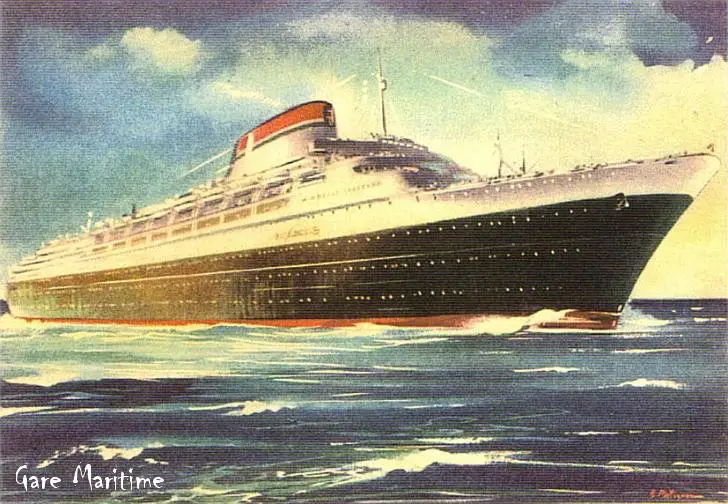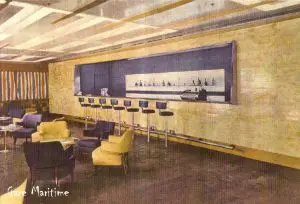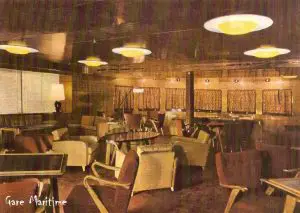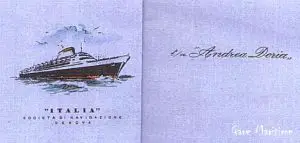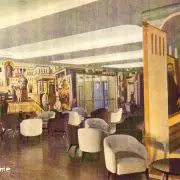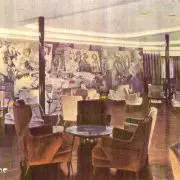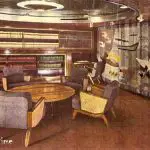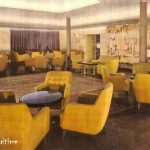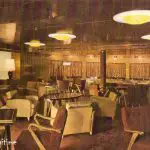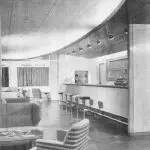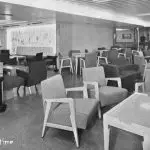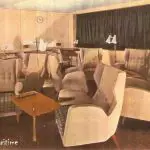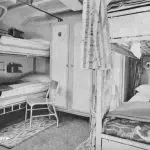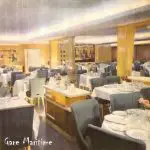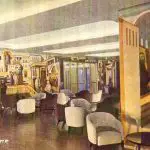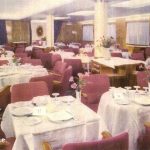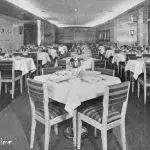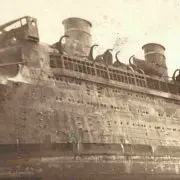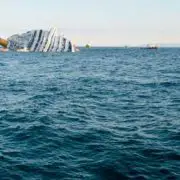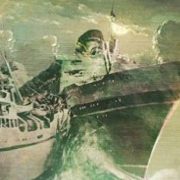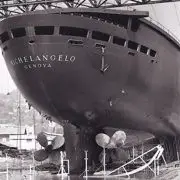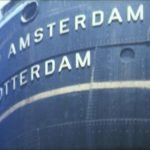Andrea Doria : The Sinking of the Unsinkable
An excerpt from Alive on the Andrea Doria! The Greatest Sea Rescue in History by Pierette Domenica Simpson
The wonder is not that the Andrea Doria sank,
but that she stayed afloat so long.
—Leonard J. Matteson
United States Maritime Law Association
ON THE MORNING OF JULY 26, 1956, CBS Evening News correspondent Douglas Edwards reported what he witnessed from a plane dipping 500 feet above the water:
There below, on glasslike water, water strewn with wreckage and oil, was the Andrea Doria, listing at a 45-degree angle and taking water by the minute . . . the ugly gash in her side covered by the Atlantic. . . . Her three swimming pools were empty of water, emptied the hard way, spilled into the ocean. . . . A few minutes past ten o’clock . . . the ship’s list was at 50 degrees. Her funnels were taking water . . . the boiling green foam increasing. . . . Three minutes later the Andrea Doria settled gracefully below the smooth Atlantic—a terrible sight to see. A Navy commander had tears in his eyes. Nobody felt anything but an awful helplessness. There was one thing to be thankful for: the loss of life was not nearly, not nearly as great as it might have been. At 10:09 it was all over, the Andrea Doria was gone.
As with the “unsinkable” Titanic, there is tragic irony in the “unsinkable” Andrea Doria account. We all know too well what caused the demise of the former: the hull breached by the ripping damage of a gigantic iceberg. But how and why did a newer ship, sailing warm waters and built to withstand a powerful impact, meet its end?
Built in Sestri, Italy, by the Ansaldo Shipyard, the Andrea Doria was modern in every respect. For safety, it was equipped with all of the most recent navigational aids that were specified in the 1948 Convention for the Safety of Life at Sea (SOLAS). This included two radar sets, instruments that became heavily relied upon in the 1950s.
As for the Doria’s nautical specifications, it was described as 697 feet long, with a beam of 90 feet, with eleven decks, and with a gross tonnage of 29,100. Its top speed of 26 knots was achieved by steam turbines developing 35,000 horsepower.
In order to understand the sinking or capsizing of any vessel, one must take into account certain standard issues. Among them are ballasting, weather, speed, location, and the type and extent of damage.
First, it must be noted that, technically, the Andrea Doria did not sink—it capsized. In responding to the issue of proper ballasting, marine surveyor Maurizio Eliseo states:
The Andrea Doria met not only the SOLAS 48 requirement of a minimum metacentric height of 0.5 foot, but a higher requirement imposed by the Italian flag authorities of no less than 1.0 foot. When it sank, its metacentric height was more than 3.3 feet. The ballasting plan and record, saved by the engine crew, were among the papers sent to the court of New York for the crew’s interrogation—which, unfortunately, never took place.
The ballasting record clearly confirms that the vessel still had 1,907 tons of fuel oil (more than sufficient to complete the return leg of its voyage); therefore, it didn’t need to fuel in New York to be properly ballasted and safe, as has been suggested elsewhere. Yes, the Doria’s fuel tanks were half empty at the time of the sinking, but it was built to return safely to Genova on the remaining fuel. This was demonstrated by the ship’s previous 100 trips and those of its sister ship, the Cristoforo Colombo.
So, why did the ship capsize? Because until SOLAS amendments entered in force in 1990, the shipbuilding industry did not consider leaks above the watertight deck as a possibility—as in the case of the Andrea Doria. Therefore, the sudden flooding of some 500 tons of water into the ruptured tanks caused the ship to list some 20 degrees3 to starboard during the first minute. Fortunately, its heavy cargo was fastened securely; otherwise, there would have been a sharper list, and the capsizing would have been swifter. All of these facts have been verified by the latest computer technology.
All experts agree: the Andrea Doria was doomed the moment it was hit; the damage occurred in its most vulnerable area. Moreover, the American Bureau of Shipping, which studied collisions, learned that previous ones of this type showed that the maximum penetration was usually less than 15 percent of the beam of the ship, whereas in the case of the Doria, penetration was closer to 25 percent. This difference is considerable. The excessive breach, in conjunction with its location between two watertight compartments, caused an excessive list which allowed water to cascade over the tops of the watertight bulkheads that extended up to A Deck. As the adjacent watertight compartments flooded, the list continued to increase, until the ship finally capsized, its fate sealed, nearly eleven hours later. Robert T. Young, a naval architect, classified surveyor, and former president of the board of the American Shipping Bureau, explains the flooding in detail:
The actual point of impact occurred between two watertight bulkheads. Located between the two bulkheads, immediately above the double-bottom of the ship, there was a battery of fuel oil tanks known as deep tanks, which extended across the full breadth of the ship with a longitudinal oil tight and watertight bulkhead on the centerline of the ship. The Stockholm’s bow penetrated all the starboard deep tanks, thereby flooding them. An effort was made to counteract the list by pumping ballast water into the port tanks; unfortunately, it had the opposite effect, because, due to the initial list, the center of gravity of the port tanks was higher than that of the starboard ones, a fact which only aggravated the condition.
The space containing the main electric generators was located between transverse bulkheads. It was in a compartment of its own, separated from the main engine room by a watertight bulkhead. The transverse bulkhead was penetrated, which flooded this generator space and short-circuited the generators and switchboards, putting them all out of action. The emergency diesel generator, which was located in its own compartment at a much higher level in the ship, started up and supplied the necessary power for the emergency lighting and bilge and ballast pumps; the emergency generator was still running when the last lifeboat left the ship.
Masquerade Dance, Details from a July 1956 menu, an Andrea Doria letterhead and the cover from an Andrea Doria Passenger List
Courtesy of Michael Poirier
 The Andrea Doria was built as a “two-compartment ship”; this denotes its ability to stay afloat when only two compartments are damaged. But as a result of the ripping-type damage, which tore open an arc of 90 degrees along the Doria’s hull, more than three compartments were compromised; in fact, many more were flooded because of longitudinal and transverse damage to the main bulkhead. It must be noted that the average penetration in a collision does not exceed one-fifth of the ship. In the case of the Doria, it was one-third. Therefore, when taking into account the ripping damage that caused continual and irregular flooding, it is clear to see why the list was on a continuum toward doom.
The Andrea Doria was built as a “two-compartment ship”; this denotes its ability to stay afloat when only two compartments are damaged. But as a result of the ripping-type damage, which tore open an arc of 90 degrees along the Doria’s hull, more than three compartments were compromised; in fact, many more were flooded because of longitudinal and transverse damage to the main bulkhead. It must be noted that the average penetration in a collision does not exceed one-fifth of the ship. In the case of the Doria, it was one-third. Therefore, when taking into account the ripping damage that caused continual and irregular flooding, it is clear to see why the list was on a continuum toward doom.
Naval architect Francesco Scotto responds to anyone who questions whether there was a missing door going to the watertight compartments or whether these doors were closed: “The watertight doors were closed perfectly at the moment in which the measures for navigating in fog were taken.”
Interior views courtesy of Jim Kalafus
Another factor that must be considered regarding the watertight compartments is that the two ships were traveling at high speeds: the Stockholm at its maximum 18.0 knots and the Doria at a slightly reduced speed of 21.8 knots. Additionally, the Stockholm hit the Doria just under the bridge wing with its steel-reinforced, ice-breaking bow. Because the Stockholm was riding lower than its target—being half its size—it had the effect of pushing the Doria to its left. In addition, since the Doria was speeding “hard to port” as ordered by its captain (in order to avoid the collision with the approaching Stockholm on its starboard side), this also caused it to lean onto its left side, further exposing the keel. Under these conditions, the keel became vulnerable to a blow from the Stockholm.
David Bright explains how he and other divers have seen evidence of the breached keel during their expeditions to the Doria:
Peter Gimbel was the first to notice the fracture in the keel on his last expedition. During this dive in 1981, he was able to go into the gift shop located in the foyer; he cut a hole into one of the ventilator shafts, which provide a passageway into the generator room; then he swam through the generator room, which led him to a large hole and directly into the ocean. So he theorized that more than three compartments had been damaged; therefore, whether there was a missing door between the watertight compartments or not wasn’t a factor in the sinking—the ship was already doomed.
Not only was the structural integrity of the starboard side breached, but because the ships were going so fast and the Stockholm was so much lower,9 in the process of pushing the Doria up into that 20-degree list, it actually exposed the keel.
When I dove the Doria in the ’80s, I saw the physical proof: from the port side, I saw a large hole that extended through to the starboard side; it was about five feet wide and even longer. Perhaps [at the time of the collision] it just started out as a hairline crack, but today this fissure has expanded throughout the hull to the point where the bow is separating from the rest of the hull.
Nautical scientists who have studied the sinking are amazed at some of the circumstances after the collision: no fires broke out, there were no explosions in spite of the fact that fuel tanks were smashed, and the emergency generators lit the disaster scene right up to the capsizing.
Scotto adds:
It would be ridiculous to attribute only luck to these [aforementioned] facts. . . . We must discuss the solid construction and, above all, note the care and management of the machinists that prevented the generators, the furnaces, and the electric stations from creating problems and harming people and property.
The greatest testament to the worthiness of the Andrea Doria as a well-constructed vessel is the reputation of its sister ship, the Cristoforo Colombo. It was also built by the Ansaldo Shipyard, with an identical design for safety, and it operated under the same standards. After the Doria’s sinking, many nautical agencies investigated the construction of the Colombo, including the U.S. Safety Commission of the House of Representatives and the U.S. Coast Guard. No one ever disputed the safety and stability of the sister ship, which continued to sail across the Atlantic Ocean for many years.
- gare doria cabin class pool bar a
- Gare doria 1 class library a
- gare doria cabin class ballroom a
- gare doria belvedere lounge a
- gare doria cabin class bar a
- gare doria tourist class lounge a
- gare doria cabin class library a
- gare doria tourist cabin a
- gare doria cabin class dining room a
- gare doria mp menu july 1956 2 a
- gare doria 1 class dining room a
- gare doria 1 class bar a
- gare doria tourist dining room a
- gare doria 1 class ballroom a

